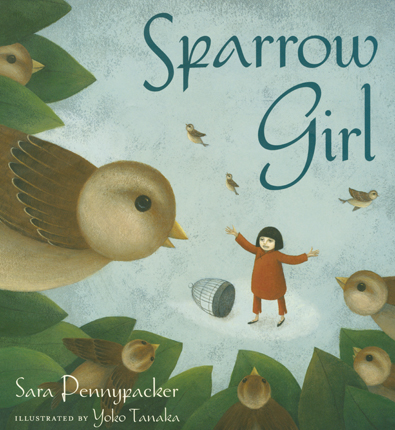Full Text Reviews: Booklist - 01/01/2009 In 1958, Chairman Mao declared war on sparrows. He blamed them for devouring the nation’s wheat crop, and he required all citizens, armed with pots and pans and firecrackers, to take to the streets and literally scare the birds to death. The successful campaign brought on a plague of locusts and a three-year famine that resulted in the deaths of almost 40 million Chinese. The author takes these actual events as inspiration for a resonant, contemporary fable about Ming-Li, a girl who feels for the sparrows under attack, defies the leader, and rescues seven birds as they fall from the sky. Pennypacker strikes a suitably moralistic tone and tells her story with rich, descriptive detail. Tanaka matches the somber elegance of the text with opaque, folk-inspired paintings in a subdued palette. An author’s note explains the difficult facts behind the story. Opposite the grave historical account, though, is an uplifitng image: on a field of white, a small nest with seven eggs promises the hope that springs from the simple actions of one empathetic heart. - Copyright 2009 Booklist. Bulletin for the Center... - 02/01/2009 Ming-Li is the youngest member of a farming family in China, and she’s distressed when the country declares war on sparrows in an attempt to save the grain fields from the birds’ depredations. As the villagers raise a clamor to drive the sparrows away from perches, the dead and dying birds drop to the ground. Even more concerned after her older brother’s pet pigeon becomes one of the victims, Ming-Li convinces her brother to help her in rescuing the few sparrows who’ve survived their fall (“Seven sparrows,” she says sadly. “When there used to be thousands”), tending them and hiding them through the winter. In the spring, the villagers discover their crops overrun by the pests the sparrows would formerly have eaten, and Ming-Li’s secretly saved flock becomes the miracle that will bring better days. This is a tender story smoothly told, based on China’s misguided 1958 attempt to eradicate sparrows, and audiences will appreciate the heroism of the young protagonist. The relentless mowing down of the sparrows makes the account rather harrowing for its likely audience, though, and the story will leave them with a lot of questions, such as how noise kills the birds and how a mere seven sparrows can do the job of the lost flocks; the end, wherein Ming-Li’s father proclaims Ming-Li a real farmer, is more random than satisfying. The illustrations have a smoothly grainy sweep that suggests oil pastels, and the controlled regularity of the modeling results in interestingly stylized scenes; the intricate and lovely sparrows, looking like delicate woodcrafting, stand out against the subdued background hues of misty landscape and dark barn. The combination distances the events somewhat (which may be for the better at its most heart-rending moments), but it’s an original and elegant look. This might make for an unusual but dramatic addition to a unit on ecology, or it could simply provide listeners with a thoughtful example of youthful activism. A brief historical note is included. DS - Copyright 2009 The Board of Trustees of the University of Illinois. School Library Journal - 03/01/2009 K-Gr 4— In 1958, in a stunning demonstration of unintended consequences, Mao Tse-tung decimated the sparrow population of China by compelling every able-bodied citizen to set off firecrackers, clang gongs, beat on drums, etc., over a three-day period. The frightened birds took wing until they dropped dead of exhaustion. Though this kept the sparrows from eating the wheat crop, it also prevented them from controlling the locust population, resulting in a famine. Pennypacker has imagined the thoughts and actions of a little girl who loves the sparrows and manages to rescue a few of them, keeping them safe in a barn and feeding them secretly in the months that follow. When the crops in her village are threatened by the insects, Ming-Li shows the farmers the birds she has tended and they release them, recognizing that the sparrows have always been their friends. While this picture book, with its murky folk-art-style illustrations, owes more to ecological concerns than historical fact, it will be useful in teaching about the potential of one person to make a difference in the world, and the potential of many humans to create disasters.—Miriam Lang Budin, Chappaqua Public Library, NY - Copyright 2009 Publishers Weekly, Library Journal and/or School Library Journal used with permission. Loading...
|



